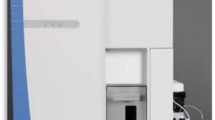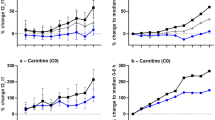Summary
Due to manifold physiological and cardioprotective actions of adenosine, the demand for a simple but accurate method to determine its concentration in plasma is increasing. The aim of this study was firstly to develop a simple isocratic method instead of the gradient elution or peak-shifting techniques used earlier and secondly to check conflicting data on the composition of “stop-solution”, added to the sample in order to prevent changes in adenosine concentration. Isocratic elution improved signal to noise ratio and concentrations of 100 μmol L−1 dipyridamole and 2.5 μmol L−1 erythro-9(2-hydroxy-3-nonyl)adenine in the blood sample effectively prevented both adenosine formation and degradation, even without the use of a 5′-ecto-nucleotidase inhibitor. Lowering the concentration of dipyridamole to 25 μmol L−1 caused more than a tenfold increase of adenosine concentration in two out of five cases and even 100 μmol L−1 dipyridamole alone is not sufficient to inhibit adenosine deaminase in blood samples.
Similar content being viewed by others
References
G. H. Möser, J. Schrader, A. Deussen, Am. J. Physiol.256, C799 (1989).
J. Ontyd, J. Schrader, J. Chromatogr.307, 404 (1984).
S. C. Herrmann, E. O. Feigl, J. Chromatogr.574, 247 (1992).
J. C. Shyrock, M. T. Boykin, J. A. Hill, L. Belardinelli, Am. J. Physiol.256, H1232 (1990).
J. P. Manfredi, H. V. Sparks, Jr., Am. J. Physiol.243, H536 (1982).
L. J. Findley, M. Boykin, T. Fallon, L. Belardinelli, J. Appl. Physiol.64/2, 556 (1988).
R. A. Hartwick, P. R. Brown, J. Chromatogr.126, 679 (1976).
R. A. Hartwick, A. M. Krstulovic, P. R. Brown, J. Chromatogr.186, 659 (1979).
J. E. McKenzie, R. P. Steffen, F. J. Haddy, Am. J. Physiol.252, H204 (1987).
A. Pelleg, R. S. Porter, Pharmacology10, 157 (1990).
L. Belardinelli, J. Linden, R. M. Berne, Progress in Cardiovascular Diseases33/1, 73 (1989).
B. D. Bertolet, J. A. Hill, Chest104, 1860 (1993).
R. E. Klabunde, D. G. Althouse, Life Sci.28, 2631 (1981).
J. Schrader, R. M. Berne, R. Rubio, Am. J. Physiol.223, 159 (1972).
C. W. Hamm, W. Kupper, R. Bredehorst, H. Hilz, W. Bleifeld, Cardiovascular Res.22, 236 (1988).
V. Kékesi, “Current problems of cardiovascular surgery”, Z. Szabó, ed., Academic Press, Budapest, 1986, p. 99.
Author information
Authors and Affiliations
Rights and permissions
About this article
Cite this article
Huszár, É., Barát, E. & Kollai, M. Isocratic high-performance liquid chromatographic determination of plasma adenosine. Chromatographia 42, 318–322 (1996). https://doi.org/10.1007/BF02290317
Received:
Revised:
Accepted:
Issue Date:
DOI: https://doi.org/10.1007/BF02290317




